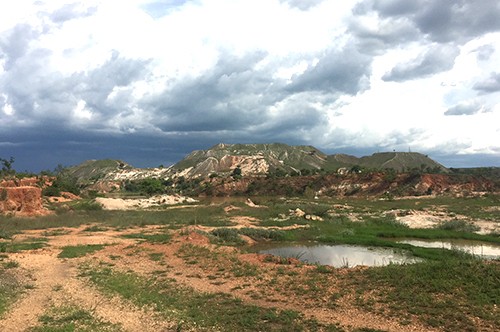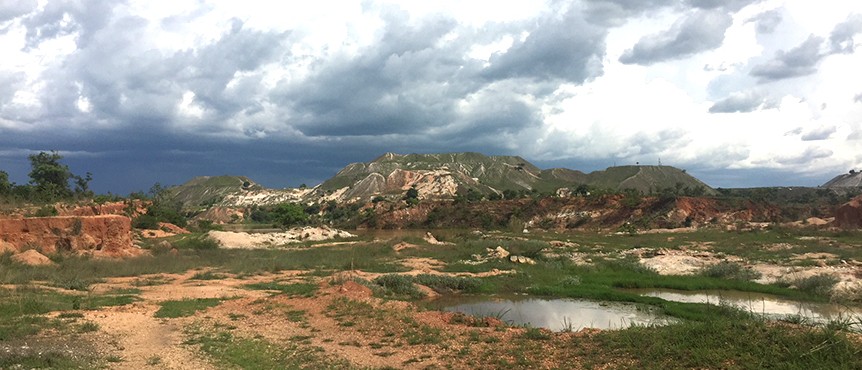A look at the high-risk, high-reward resources in the heart of Africa.


The DRC is widely considered the resource-richest country in the world, with vast deposits of copper, cobalt, zinc, iron and uranium in the south, diamonds in the west and gold in the north. The largest mines in the country are situated in the Katanga province from where the majority of the world’s cobalt is extracted. While the use of the metal can be traced back as far as 2,600 years ago as cobalt-containing glazes have been found in Ancient Egyptian tombs, the word cobalt was coined a couple of centuries ago by superstitious German miners who feared the deadly fumes arising from the processing of metals like silver and copper. Although the vapors actually came from the arsenic also contained in the ore, the word “kobold,” which means goblin, has stuck ever since.
In the DRC, the history of cobalt started in 1914 with the discovery of the world’s biggest deposits in the Katanga region. Cobalt is not a particularly rare metal; ranked at 32 in global abundance by the Cobalt Institute, it can be found in the soil, in mineral deposits and even in crusts on the seafloor. However, the metal is always combined with other elements like nickel, copper, iron or arsenic, and it is primarily extracted as byproduct of mining for other metals —especially nickel and copper. Cobalt in the Katanga region is especially attractive as centuries of copper mining have left significant resources in easily exploited old mine tailings and workings. Mining companies are, however, scrambling to find cobalt elsewhere. In 2018, production and processing company Lithium Australia announced discovered cobalt mineralization at mines in Eichigt, Germany; Perth-based Europan Cobalt is exploring for cobalt at two sites in Slovakia and one in Finland; Hatsolabased FinnCobalt is looking to extract cobalt from the Hautalampi cobalt, nickel and copper mine in Finland while Canadian Boreal Metals is also looking to Scandinavia for cobalt extraction. Despite this, Benchmark Mineral Intelligence has estimated that global cobalt supply coming from the DRC is set to go up from 66% in 2017 to 73% by 2023.
The sheer size of the deposits in the DRC, and with massive projects like those of Glencore and Eurasian Resources Group, these mostly early-stage projects in Europe – in addition to a number of impending operations in Canada and Australia – are likely to pale in comparison. In addition, Katanga still holds some of the world’s highest-grade copper deposits, many of which are estimated to have an average ore grade of over 3%, far higher than the global average of between 0.6% and 0.8%, and some as high as 5%. The source of the cobalt-copper riches is the Central African Copperbelt, which straddles the border between Zambia and the DRC. Following the DRC’s independence in 1960, the existing mines in the Copperbelt region were nationalized, but minimal scientific work was conducted in the following decades. It was not until the country opened up for international mining companies in the late 1990s and early 2000s that the Copperbelt was studied. “From a geological perspective, the Copperbelt has the following composition: There is one central elevated area with steep sides to the north and the south, which is located north of the Zambian Copperbelt,” said Tobias Posel, director of consultancy and contracting company GeoQuest. “This belt hosts mineralized deposits, mainly coppercobalt as a stratiform unit, with associated manganese that companies do not necessarily want, as well as iron that is not economical to mine. There are also contaminants such as cadmium and uranium that exploration companies struggle to separate from the copper.”
Yet, by Posel’s estimate some 50% of the Copperbelt remains unexplored, the result of low levels of exploration work coupled with the high exploration expenses brought on by the lack of organized historical data. However, a combination of corporate and governmental efforts to map out more of the country’s resource potential will contribute to more exploration work in the future. The government has launched a World Bank-funded program to digitally capture some of the country’s geology while mining and exploration companies are using increasingly advanced techniques to identify potential resources. “Modern exploration techniques such as airborne magnetic and electromagnetic surveys are an easy and a very successful method to make discoveries,” said Peter Ruxton, principal at Tembo Capital Management. “Artificial intelligence systems are now being used to identify key fingerprints that you can then match against your existing database to aid discovery.”
In addition, advances in mining technology will increasingly enable beneficiation of byproducts of the target metal, such as uranium and manganese, opening new markets for the DRC’s largely untapped resources. In addition, technological innovation has the ability to bolster profits and undermine human rights violations in the DRC’s gold industry. Companies are increasingly investing in blockchain and other tracking technology to ensure ethical sourcing of commodities. For example, the Kampene Gold Pilot – which is part of a German-Congolese technical cooperation project – is an ongoing initiative aimed at ensuring legal gold supply chains in the northeast of the DRC. Eastern DRC is home to an estimated 200,000 artisanal gold miners who work across approximately 1,000 mine sites. While the country’s annual artisanal gold production is estimated at between 10 mt and 20 mt, the vast majority of the commodity is smuggled across the border to Rwanda, Uganda and Burundi. The pilot initiative – focused on artisanal production sites around Kampene town in the Maniema province – uses GPS-backed electronic registration of individual gold supply chain participants and transactions, with automatic transmission to an online database.
More than anything, the unlocking of the DRC’s full resource potential will, for the foreseeable future, depend on the ability of government and the corporate and international communities’ ability to create an attractive business environment in the country.

The DRC is widely considered the resource-richest country in the world, with vast deposits of copper, cobalt, zinc, iron and uranium in the south, diamonds in the west and gold in the north. The largest mines in the country are situated in the Katanga province from where the majority of the world’s cobalt is extracted. While the use of the metal can be traced back as far as 2,600 years ago as cobalt-containing glazes have been found in Ancient Egyptian tombs, the word cobalt was coined a couple of centuries ago by superstitious German miners who feared the deadly fumes arising from the processing of metals like silver and copper. Although the vapors actually came from the arsenic also contained in the ore, the word “kobold,” which means goblin, has stuck ever since.
In the DRC, the history of cobalt started in 1914 with the discovery of the world’s biggest deposits in the Katanga region. Cobalt is not a particularly rare metal; ranked at 32 in global abundance by the Cobalt Institute, it can be found in the soil, in mineral deposits and even in crusts on the seafloor. However, the metal is always combined with other elements like nickel, copper, iron or arsenic, and it is primarily extracted as byproduct of mining for other metals —especially nickel and copper. Cobalt in the Katanga region is especially attractive as centuries of copper mining have left significant resources in easily exploited old mine tailings and workings. Mining companies are, however, scrambling to find cobalt elsewhere. In 2018, production and processing company Lithium Australia announced discovered cobalt mineralization at mines in Eichigt, Germany; Perth-based Europan Cobalt is exploring for cobalt at two sites in Slovakia and one in Finland; Hatsolabased FinnCobalt is looking to extract cobalt from the Hautalampi cobalt, nickel and copper mine in Finland while Canadian Boreal Metals is also looking to Scandinavia for cobalt extraction. Despite this, Benchmark Mineral Intelligence has estimated that global cobalt supply coming from the DRC is set to go up from 66% in 2017 to 73% by 2023.
The sheer size of the deposits in the DRC, and with massive projects like those of Glencore and Eurasian Resources Group, these mostly early-stage projects in Europe – in addition to a number of impending operations in Canada and Australia – are likely to pale in comparison. In addition, Katanga still holds some of the world’s highest-grade copper deposits, many of which are estimated to have an average ore grade of over 3%, far higher than the global average of between 0.6% and 0.8%, and some as high as 5%. The source of the cobalt-copper riches is the Central African Copperbelt, which straddles the border between Zambia and the DRC. Following the DRC’s independence in 1960, the existing mines in the Copperbelt region were nationalized, but minimal scientific work was conducted in the following decades. It was not until the country opened up for international mining companies in the late 1990s and early 2000s that the Copperbelt was studied. “From a geological perspective, the Copperbelt has the following composition: There is one central elevated area with steep sides to the north and the south, which is located north of the Zambian Copperbelt,” said Tobias Posel, director of consultancy and contracting company GeoQuest. “This belt hosts mineralized deposits, mainly coppercobalt as a stratiform unit, with associated manganese that companies do not necessarily want, as well as iron that is not economical to mine. There are also contaminants such as cadmium and uranium that exploration companies struggle to separate from the copper.”
Yet, by Posel’s estimate some 50% of the Copperbelt remains unexplored, the result of low levels of exploration work coupled with the high exploration expenses brought on by the lack of organized historical data. However, a combination of corporate and governmental efforts to map out more of the country’s resource potential will contribute to more exploration work in the future. The government has launched a World Bank-funded program to digitally capture some of the country’s geology while mining and exploration companies are using increasingly advanced techniques to identify potential resources. “Modern exploration techniques such as airborne magnetic and electromagnetic surveys are an easy and a very successful method to make discoveries,” said Peter Ruxton, principal at Tembo Capital Management. “Artificial intelligence systems are now being used to identify key fingerprints that you can then match against your existing database to aid discovery.”
In addition, advances in mining technology will increasingly enable beneficiation of byproducts of the target metal, such as uranium and manganese, opening new markets for the DRC’s largely untapped resources. In addition, technological innovation has the ability to bolster profits and undermine human rights violations in the DRC’s gold industry. Companies are increasingly investing in blockchain and other tracking technology to ensure ethical sourcing of commodities. For example, the Kampene Gold Pilot – which is part of a German-Congolese technical cooperation project – is an ongoing initiative aimed at ensuring legal gold supply chains in the northeast of the DRC. Eastern DRC is home to an estimated 200,000 artisanal gold miners who work across approximately 1,000 mine sites. While the country’s annual artisanal gold production is estimated at between 10 mt and 20 mt, the vast majority of the commodity is smuggled across the border to Rwanda, Uganda and Burundi. The pilot initiative – focused on artisanal production sites around Kampene town in the Maniema province – uses GPS-backed electronic registration of individual gold supply chain participants and transactions, with automatic transmission to an online database.
More than anything, the unlocking of the DRC’s full resource potential will, for the foreseeable future, depend on the ability of government and the corporate and international communities’ ability to create an attractive business environment in the country.